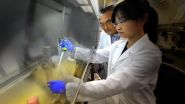(Press-News.org) Women are significantly underrepresented in many science, technology, engineering, and math (STEM) fields, and attempts to understand why have only resulted in disagreement among researchers, the lay public, and policymakers. In a comprehensive new report, an interdisciplinary team of psychological scientists and economists aims to cut through the confusion, synthesizing available research and providing a host of new analyses to identify the factors that drive women's underrepresentation in STEM. Their analyses show that, despite many differences between the sexes prior to college — reflected in occupational preferences, math ability, cultural attitudes, and amount of AP coursework taken, for example — the playing field eventually levels for women who continue in most these fields once they earn their PhD.
In the report, psychological scientists Stephen J. Ceci and Wendy M. Williams (Cornell University) and economists Donna K. Ginther (University of Kansas) and Shulamit Kahn (Boston University) focus specifically on data collected since 2000 from various scientific disciplines in order to provide an up-to-date look at women in science. Their findings paint a complex portrait:
"No single cause or single sweeping statement accurately captures why women are found in short supply in some fields," says Ceci. "Rather, the causes are complex and involve multiple factors that operate at different stages of the life course."
The full report and an accompanying commentary by Diane Halpern (Minerva Schools at the Keck Graduate Institute) are published in Psychological Science in the Public Interest, a journal of the Association for Psychological Science.
As expected, the report shows that women are underrepresented in college majors, graduate school programs, and professional fields that are the most mathematically-intensive, such as geoscience, engineering, economics, mathematics/computer science, and the physical sciences (GEEMP). In 2011, for example, women received only 25% of GEEMP bachelor's degrees, and women comprise only 25% to 44% of tenure-track assistant professors in GEEMP fields.
Taking a life course perspective, the researchers find that the roots of these disparities have early origins. Gender differences in attitudes toward and expectations about math careers and ability seem to emerge as early as kindergarten and increase thereafter, leading girls to be less likely to major in math-intensive subjects in college and more likely to major in non-math-intensive sciences, such as biology and social sciences. And these disparities only continue on through graduate-level education.
For those women who do receive a PhD in a math-intensive science, however, the playing field actually seems to be level. Women are equally (or more) likely as men to be invited to interview for a tenure-track job or be offered such a job. Women and men receive comparable salaries and show comparable promotion rates, and they have similar journal acceptance rates and grant funding rates. They also show similar levels of persistence and hours worked, and they express similar levels of career satisfaction.
There are some exceptions to these trends, but they are exceptions, not the norm, says Ceci:
"The data show that the biases and barriers that resulted in attrition of women from academic science in the past have largely been surmounted and the causes of modern underrepresentation have changed. By focusing on historical biases we risk misdirecting resources away from the current causes of women's underrepresentation."
Paradoxically, the data suggest that women are actually more likely to leave scientific fields in which they are already well-represented — such as life sciences, psychology, and social sciences (LPS). Women in math-intensive fields — the very fields in which they are most underrepresented — segue from undergraduate to graduate school to tenure-track professorships at rates comparable to men. In contrast, it is in those fields in which women are well-represented, such as LPS, that they tend more to drop out of the pipeline.
According to Halpern, one of the most important features of the report is that it separates math-intensive fields (GEEMP), in which women are underrepresented, from non-math-intensive fields (LPS fields), in which women are overrepresented or at parity.
"This distinction should change the nature of future research," says Halpern. "We can no longer talk about gender gaps in science, technology, engineering, and mathematics (STEM fields) as though they are homogeneous across disciplines."
Thus, increasing women's representation in academic science not only requires a shift in emphasis toward GEEMP fields in particular, but also a shift away from alleged bias in the academy toward interventions that are targeted at earlier time points in the lives of girls and women.
Such interventions may include programs, beginning as early as elementary school, designed to encourage girls to engage and achieve in GEEMP fields like engineering, computer science, and physics. At the university level, enticing women to switch to GEEMP majors depends on requiring early science coursework, since women switch to GEEMP majors more often than men but only if they have taken introductory science courses early in their college career. And still later, interventions must focus on fostering work-life balance for talented PhDs who are at greater risk of opting out of tenure-track positions.
"Our hope is that this research synthesis, coupled with the numerous new analyses we have provided in this article, will help to redirect the debate toward critical issues that are most important in limiting the careers of women scientists today, and hopefully move closer to solving them," Ceci, Williams, Ginther, and Kahn write.
INFORMATION:
The report, "Women in Academic Science: A Changing Landscape," and the accompanying commentary, "It's Complicated—In Fact, It's Complex: Explaining the Gender Gap in Academic Achievement in Science and Mathematics" are available free to the public online at: http://www.psychologicalscience.org/index.php/publications/women-in-academic-science.html?utm_source=pressrelease&utm_medium=eureka&utm_campaign=PSPI
The researchers discuss the report and its main findings in a video produced by the Cornell Institute for Women in Science, available at: http://youtu.be/BN6_sCWveO4
For a copy of the report and access to other Psychological Science in the Public Interest research findings, please contact Anna Mikulak at 202.293.9300 or amikulak@psychologicalscience.org.
New York | Heidelberg, 3 November 2014 -- A new theoretical work establishes a long-sought-after connection between nuclear particles and electromagnetic theories. Its findings suggest that there is an equivalence between generalised Casimir forces and those that are referred to as weak nuclear interactions between protons and neutrons. The Casimir forces are due to the quantisation of electromagnetic fluctuations in vacuum, while the weak nuclear interactions are mediated by subatomic scale particles, originally called mesons by Yukawa. These findings by Barry Ninham ...
This news release is available in French. A team of researchers from Inserm led by Paul Hofman (Inserm Unit 1081/University of Nice) has just made a significant advance in the area of early diagnosis of invasive cancers. In a study which has just been published in the journal PLOS ONE, the team shows that it is possible to detect, in patients at risk of developing lung cancer, early signs, in the form of circulating cancer cells, several months, and in some cases several years, before the cancer becomes detectable by CT scanning. This warning could play a key role in ...
WASHINGTON, Nov. 3, 2014 — As Carl Sagan famously said, "We are made of star stuff." It's a mind-boggling thought, but what exactly did he mean? Ahead of Sagan's birthday on November 9th, Reactions teamed up with the American Association of Chemistry Teachers (AACT) and best-selling author Sam Kean to explain the chemistry behind this iconic quote. Watch our latest episode to find out how many of the atoms that make up you (and everything else) were forged in the nuclear cores of stars billions of years ago. Watch the video here: http://youtu.be/2bm479V8qPs.
INFORMATION:
Kean's ...
This news release is available in Spanish. Biological membranes define the functional architecture of living systems: they are selectively permeable, maintain the chemical identity of the cells and intracellular organelles, and regulate the exchange of material between them. To control the transporting of ions and small molecules through cell membranes, highly specialised proteins that transport these molecules through the membrane are used. Recent advances in nanotechnology and nanofabrication have made it possible to synthesise and manufacture artificial compounds ...
CHICAGO (November 3, 2014): Researchers from the University Health Network in Toronto are hoping to improve the operational efficiency of bariatric surgery programs to increase access to care. Studies have shown that bariatric operations can alleviate chronic health issues like diabetes and arthritis for extremely obese people. Now the University Health Network researchers are trying to determine why many patients who are referred for a bariatric operation do not ultimately have the procedure performed, despite being in a publicly funded health care program. Findings ...
Virginia Commonwealth University (VCU) Massey Cancer Center researchers have developed the first and only tool that can accurately measure cancer health literacy (CHL) and quickly identify patients with limited CHL. This tool has the potential to improve communication and understanding between physicians and patients, which, in turn, could lead to better clinical outcomes.
Recently published in the Journal of Health Communications, the Cancer Health Literacy Study was conducted over four years and involved 1,306 African-American and Caucasian patients from Massey and ...
San Diego — A nasal vaccine in development by researchers at The University of Texas at Austin has been shown to provide long-term protection for non-human primates against the deadly Ebola virus. Results from a small pre-clinical study represent the only proof to date that a single dose of a non-injectable vaccine platform for Ebola is long-lasting, which could have significant global implications in controlling future outbreaks. This work is being presented Nov. 5 at the 2014 American Association of Pharmaceutical Scientists (AAPS) Annual Meeting and Exposition, ...
AUGUSTA, Ga. – Fat and sugar aren't usually considered healthy staples, but scientists have found that a biological fat with a sugar attached is essential for maintaining the brain's store of stem cells.
Neural stem cells help the brain develop initially, then repopulate brain cells lost to usual cell turnover as well as to a trauma or malady, such as a head injury or stroke.
While the cell population and activity decrease as a natural part of aging, scientists at the Medical College of Georgia at Georgia Regents University are studying how neural stem cells ...
The school environment in which teachers work is related to their expectations of students, according to a new study by researchers at the University of Montreal. "It is known that low teacher expectations are negatively associated with student achievement and school effectiveness. While we know that expectations are primarily determined by the specific characteristics of teachers, we have shown that the school environment also plays a determining role," says lead author of the study, Marie-Christine Brault, a post-doctoral researcher at the university's Institut de recherche ...
What we believed as children about the soul and the afterlife shapes what we believe as adults – regardless of what we say we believe now, according to a new Rutgers study.
"My starting point was, assuming that people have these automatic – that is, implicit or ingrained – beliefs about the soul and afterlife, how can we measure those implicit beliefs?," said Stephanie Anglin, a doctoral student in psychology in Rutgers' School of Arts and Sciences.
Her research, "On the Nature of Implicit Soul Beliefs: When the Past Weighs More Than the Present," ...

